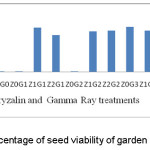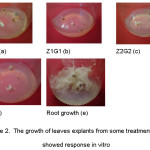Introduction
Impatiens balsamina is well known as herbaceous flowering plants. Flower of garden balsam suitable for using as bedding plants in a landscape design or potted plants. The flowers size are varied from single layer (originally) to multiple layers. Flowers contain anthocyanin that varied between red, purple, pink and white colour of flowers. One plant has one colour of flower and flowering time started at six to eight weeks after planting. Secondary metabolite also observed in the roots that can be used as traditional medicine. Lawsone is one of 1,4- naphthoquinone (1,4-NQ) natural product produce by garden balsam.1 Oryzalin study on garden balsam was conducted to improve plant performance and flower set. Plant height was decreased 54% by 0.01% oryzalin treatment and plant performance was compact with increasing weight of flower.2 Flowers size increased up to 17% in diameter due to treatment of 0.02% oryzalin for 12 hours of soaking for the seedlings (unpublished data). Increase of flower diameter was not followed by enhancement of flower petals.
Other mutagenic agent was gamma radiation. Gamma ray can improve the quality of flower colour where there are two colour in one flower set (chimera flower). Some study was conducted for gamma ray treatment in flowering plants. The amount of radiation is depended on plant species. Garden balsam plant produce flower with lighter colour intensity of red due to gamma treatment.3 Physical mutagenic agent increased electromagnetic radiation that improve plant performance.4 Hibiscus sabdariffa that radiated 600 Gy showed enhancement of number of fruit per plant and also anthocyanin.5 Irradiation of Gamma at 20 Gy dose enhanced concentration of soluble sugars, protein and proline content and peroxidase activities and superoxide dismutase on leaves of soybean when plant was exposed to drought condition.6 Genetic variance some genotypes of chili very high after irradiated by Gamma ray.7
Seeds of garden balsam mutant plants were difficult to germinate and required longer time to emerge the radicula due to effect of oryzalin on cell division. Gibberellin is a hormone for increasing percentage of germination of dormant seeds. At the earlier stage of growth, concentration of Gibberellin was very high in plant roots.8 Tissue culture can assist rapid plant multiplication using MS media that enriched with hormones.
The objective of study was increasing multiplication of mutant plant using NAA and BAP hormone aseptically.
Materials and Methods
Plant treatments (in vivo)
In the previous study, seedlings of garden balsam were treated by soaking in oryzalin (0.00% (Z0), 0.01% (Z1), 0.02% (Z2)) for 12 hours,2 then planted in the field until four times to gain M4 generation. Seeds from M4 were germinated in vivo for 7 days then exposed to gamma radiation 60Co (0 (G0), 5 (G1),10 (G2),15 (G3) Gy) and planted in the field to know flower colour and collect the seed of M5 for in vitro study.3
In vitro study
In vitro technique was conducted for rapid multiplication of mutant plant in order to gain polyploid plant. Seeds M5 were collected and germinated. Soaking M5 seeds in Gibberellin acid (GA) 0.1% for 24 hours to assist germination of mutant seeds. Furthermore, leaf explants from germinated seeds were cultured aseptically in sterile MS media (4.4 g/L) supplemented by 30% sugar/L, 0.5 ppm NAA and 0.5 ppm BAP , 8 g/L agar and pH was 5.8.
Chromosome analysis
Chromosome analysis is used for ploidy status of mutant plant. Squash methods with modification was applied for chromosome.9 Root tip (5 mm) was collected at 07.00-08.00 am. Root tip was treated with 0,002 mol 8-hydroxyquinolin for 6 hours then soaked in Farmer fixative for 2 hours at room temperature. Next step was added some drops of 1 N HCl for 30 seconds then heated at 60oC and washed. Root tip was colored with aceto orcein and covered by cover glass then squashing the root tip. Number of chromosome was counted from root tip under microscope.
Secondary metabolite analysis
Roots from treated explants that grew vigorously was analyzed for secondary metabolite to know the effect of mutagenic agent on metabolite compound. Liebermann Burchard method was used for alkaloid. Mayer reaction was used for terpenoid and Wagner reaction was used for steroid analysis in the roots explants.
Data collection
Data were collected for seeds viability, chromosome number, growth of explants and form of secondary metabolites.
Results
Generally, M5 explants growth showed different performance in vitro after treated by oryzalin and gamma radiation. Control leaf explants showed small white shoots and callus. Treated explants had white shoots and one treatment showed roots (Figure 2.e)
Seeds viability
Growth percentage of seedlings reached 90% by soaking of seeds using gibberellin 0.01 ppm for 24 hours, except for Z2G0 (0.02% oryzalin and 0 Gy), Z0G1(0.00% oryzalin and 5 Gy) and Z0G2 (0.00% oryzalin and 10 Gy) treatment (Figure1).
 |
Figure 1: The percentage of seed viability of garden balsam mutant M5 Click here to View figure |
Chromosome number
Number of chromosome was decreased from 14 (diploid) to 7 – 11 (mixoploid) in treated explants. In this study, chromosome number of garden balsam reduced almost 50% after seedlings was treated with Gamma ray. Type of garden balsam chromosome had studied by.10
The growth of leaves explants
Leaf explants showed different development for any treatment. Explants from control showed hairy shoots at 6 weeks after cultured. Leaves could develop into shiny shoots due to vitrification. Others leaf developed into callus in two weeks, however the callus become dormant. Leaf explants also develop into multiple roots (Figure 2).
 |
Figure 2: The growth of leaves explants from some treatments that showed response in vitro |
Secondary metabolite
Secondary metabolites ( alkaloids and terpenoids ) in the roots extract was not changed by oryzalin and gamma radiation. Type of metabolite was alkaloid and terpenoid both in control and treated explants.
Discussion:
Seed viability
Mutagenic agent that had been used (oryzalin and gamma radiation) influence the ability of root emergence in garden balsam. Time of germination become longer because of disturbance on radicule growth. In other study, soybean cv. Argomulyo showed genetic diversity in plants after treated by 200 Gray of Gamma radiation.11
Chromosome number
Chimera were obtained from mutant plants at M5 generation. Level of ploidy was mixoploid between 7 to 11. Number of chromosome decreased due to gamma irradiation and oryzalin. In leaf explants of Euphorbia pulcherrima grown in media that enriched by oryzalin (28.9 µM to 144 µM) aseptically can produce diploid callus but adventitious shoots was not performed.12
Explant growth
The growth of leaf explants showed that mutant plant had different type of growing. Development of glossy shoots was due to lack of cytokinin hormone for initial growth of leaf explants. Each explants also develop into hairy roots without any shoots. In orchids, MS media can improve growth of Vanda helvola protocorm.13
Acknowledgements
Authors thank to RISTEKDIKTI for support funding the study from scheme Hibah Fundamental 2015.
References
- Widhalm J.R. and D. Rhodes. Biosynthesis and molecular actions of specialized 1,4-naphthoquinone natural products produced by horticultural plants. Horticulture Research. 2016;3, doi:10.1038/hortres.2016.46.
CrossRef - Defiani M.R., D.N. Suprapta, I.M. Sudana, N.P. Ristiati. Oryzalin treatment modified plant morphology of Impatiens balsamina L. Current World Environment Journal. 2013;8(1):23-27.
CrossRef - Defiani M.R, Sudatri N.W. Aplikasi oryzalin dan sinar gamma pada tanaman pacar air (Impatiens balsamina L.). Prosiding Seminar Nasional Sains dan Teknologi. 2014.
- Qosim W.A, Purwanto R, Wattimena G.A, Witjaksono. Pengaruh iradiasi sinar gamma terhadap kapasitas regenerasi kalus nodular tanaman manggis. Hayati Journal.Biosci. 2007;14(4):140-144.
CrossRef - El Sherif F, Khattab S. Ghoname E, Salem N and Radwan K. Effect of Gamma Irradiation on Enhancement of Some Economic Traits and Molecular Changes in Hibiscus Sabdariffa L. Life Science Journal. 2011;8(3):220-229.
- Moussa H. R. Low dose of gamma irradiation enhanced drought tolerance in soybean. Bulg. J. Agric. Sci. 2011;17:63-72.
CrossRef - Gaswanto, R., M. Syukur, B.S. Purwoko and S.H. Hidayat. Induced Mutation by Gamma Rays Irradiation to Increase Chilli Resistance to Begomovirus. AGRIVITA. 2016;38(1):24-32. doi: 10.17503/agrivita.v38i1.581.
CrossRef - Crochowska M.J., G.J. Buta, G.L. Steffens, M.Faust. Endogenous auxin and gibberellins levels in low and high vigor apple seedlings. Acta Horticulturae. 1984;146(13).
CrossRef - Berlyn G.P. and J.P. Miskche. Botanical Microtechnique and Cytochemistry. The Iowa States University Press. USA. 1976.
- Momtaz, U.S.N., G. Kabir, M.M. Ud-deen and N.Yasmin. Karyotipic study of seven types of Impatiens balsamina, L. Journal of Biological Science. 2007;15:147-152.
- Hanafiah D.S., Trikoesoemaningtyas, Yahya S., Wirnas D. Induced mutations by gamma ray irradiation to Argomulyo soybean (Glycine max) variety. Bioscience. 2010;2(3):121-125 .
- Pickens K.A. and Cheng Z.M. Effect of colchicine and oryzalin on callus and adventitious shoot formation of Euphorbia pulcherrima ‘Winter Rose’. HortScience. 2006;41(7):1651-1655.
- Muharyati Y., M.R. Defiani, N.P.A. Astiti. Growth of Vanda helvola on medium enriched by tomato juice. Metamorfosa Journal. 2015;11(2):66-71.
